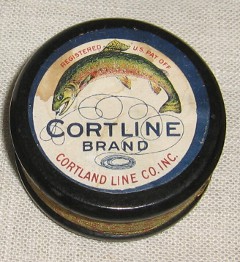Hey folks, you won't find a more honest person than Guido Orlandi. Plus he's a very good cue maker. This stuff is new to him, I'm the one that posted the possibility of it being available. I believe it was sold to him as being Cortland Linen, so we'll get the information off the spools & make sure. He measured the line & it is .025 in diameter. In the picture above , the spooled linen is spelled Cortline, The real stuff is spelled Cortland, it was 27 lb test line & "9" was the number of strands in the woven line.
QUOTE Cortland being the largest manufacturer of fishing line at the time was the most popular choice, it came in black, dark green, tan and white with green specks.
The line was braided from X number of strands depending on the pound test rating.
Cortland 9 strand was rated at 27 lb test (3 lb per strand) and measures about .025" in diameter, this diameter became the most popular choice. I've seen cues with thinner diameter, probably 7 strand.
Cortland stopped production in 1976 and Penn continued making it for a few more years - Gus Szamboti used Penn after Cortland stopped production.
These braided lines were also made and used by cuemakers in dacron, nylon and silk.
The advantage to fishing line is its consistency in diameter and uniformity of the green specks. It had to be perfect as they made it by the mile and spooled it on spools from 50 yards and up. It couldn't be 27 lb test at one point and a lesser rating at another point. UNQUOTE
It is not braided, it is cable wound.
As for what you said about the name and spelling, this pic should straighten that out for you. The "real stuff", as you put it, is indeed spelled Cortline. The company was Cortland.

.
